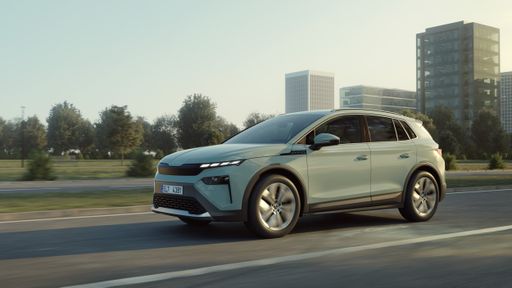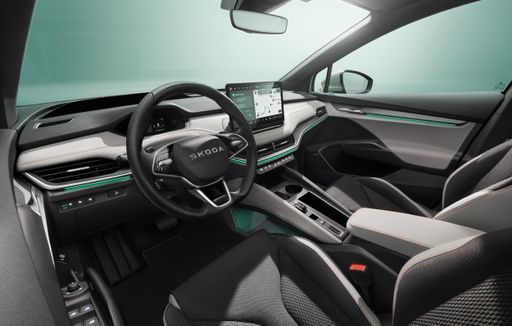Isuzu D-Max vs Skoda Elroq – Differences & prices compared
Compare performance, boot space, consumption and price in one view.
Find out now: which car is the better choice for you – Isuzu D-Max or Skoda Elroq?
The Isuzu D-Max (Pickup) comes with a Diesel engine and Automatic transmission. In comparison, the Skoda Elroq (SUV) features a Electric engine with Automatic transmission.
When it comes to boot capacity, the Isuzu D-Max offers , while the Skoda Elroq provides 470 L – depending on how much space you need. If you’re looking for more power, decide whether the 163 HP of the Isuzu D-Max or the 340 HP of the Skoda Elroq suits your needs better.
In terms of consumption, the values are 8.90 L per 100 km for the Isuzu D-Max, and 15.20 kWh for the Skoda Elroq.
Price-wise, the Isuzu D-Max starts at 38100 £, while the Skoda Elroq is available from 29100 £. Compare all the details and find out which model fits your lifestyle best!
Isuzu D-Max
The Isuzu D-Max stands out in the pickup truck market with its robust design and impressive durability, making it a reliable choice for both work and leisure. Its interior blends practicality with a touch of comfort, featuring user-friendly technology that enhances the driving experience. This vehicle's off-road capabilities and strong performance make it a versatile companion for tackling a variety of terrains.
detailsSkoda Elroq
The Elroq stands out in the automotive world with its striking design and a bold presence on the road. Boasting an interior that balances luxury and functionality, it provides an engaging driving experience for enthusiasts and casual drivers alike. With its innovative features and attention to detail, the Elroq redefines what consumers can expect from modern automobiles.
details @ skoda-storyboard.com
@ skoda-storyboard.com
 @ skoda-storyboard.com
@ skoda-storyboard.com
 @ skoda-storyboard.com
@ skoda-storyboard.com

|
|
|
|
|
Costs and Consumption |
|
|---|---|
|
Price
38100 - 50100 £
|
Price
29100 - 46800 £
|
|
Consumption L/100km
8.9 - 9 L
|
Consumption L/100km
-
|
|
Consumption kWh/100km
-
|
Consumption kWh/100km
15.2 - 16.4 kWh
|
|
Electric Range
-
|
Electric Range
377 - 580 km
|
|
Battery Capacity
-
|
Battery Capacity
52 - 79 kWh
|
|
co2
233 - 235 g/km
|
co2
0 g/km
|
|
Fuel tank capacity
76 L
|
Fuel tank capacity
-
|
Dimensions and Body |
|
|---|---|
|
Body Type
Pickup
|
Body Type
SUV
|
|
Seats
4 - 5
|
Seats
5
|
|
Doors
2 - 4
|
Doors
5
|
|
Curb weight
2040 - 2115 kg
|
Curb weight
1949 - 2270 kg
|
|
Trunk capacity
-
|
Trunk capacity
470 L
|
|
Length
5280 mm
|
Length
4488 mm
|
|
Width
1870 mm
|
Width
1884 mm
|
|
Height
1790 mm
|
Height
1625 - 1637 mm
|
|
Payload
985 - 1060 kg
|
Payload
466 - 531 kg
|
Engine and Performance |
|
|---|---|
|
Engine Type
Diesel
|
Engine Type
Electric
|
|
Transmission
Automatic
|
Transmission
Automatic
|
|
Transmission Detail
Automatic Gearbox
|
Transmission Detail
-
|
|
Drive Type
All-Wheel Drive
|
Drive Type
Rear-Wheel Drive, All-Wheel Drive
|
|
Power HP
163 HP
|
Power HP
170 - 340 HP
|
|
Acceleration 0-100km/h
12.60 s
|
Acceleration 0-100km/h
5.4 - 9 s
|
|
Max Speed
180 km/h
|
Max Speed
160 - 180 km/h
|
|
Torque
360 Nm
|
Torque
310 - 679 Nm
|
|
Number of Cylinders
4
|
Number of Cylinders
-
|
|
Power kW
120 kW
|
Power kW
125 - 250 kW
|
|
Engine capacity
1898 cm3
|
Engine capacity
-
|
General |
|
|---|---|
|
Model Year
2024
|
Model Year
2025
|
|
CO2 Efficiency Class
G
|
CO2 Efficiency Class
A
|
|
Brand
Isuzu
|
Brand
Skoda
|
Isuzu D-Max
The Powerhouse on Wheels: An Overview of the Isuzu D-Max
When it comes to robust and reliable pick-up trucks, the Isuzu D-Max stands out as a formidable contender. With its range of versatile models and a reputation for toughness, the D-Max caters to the needs of both commercial users and off-road adventurers. This article delves into the technical details and innovative features that make the Isuzu D-Max a leader in its class.
Under the Bonnet: Performance and Specifications
At the heart of the Isuzu D-Max lies a 1.9-litre turbocharged diesel engine, producing a power output of 163 PS (120 kW) and a torque of 360 Nm. This robust engine is paired with either a six-speed manual or a six-speed automatic transmission, offering flexibility and control for diverse driving conditions. With a top speed of 180 km/h, the D-Max balances power and performance, making it well-suited for both urban environments and rugged terrains.
Efficiency and Eco-Standards
Fuel efficiency is a pivotal factor for many buyers, and the Isuzu D-Max delivers with a consumption ranging from 8.1 to 9.2 L/100km. Despite its impressive capabilities, the D-Max falls into CO2 efficiency class G, with emissions between 212 and 241 g/km. While this places it towards the higher end of the emissions spectrum, its efficiency is commendable considering its size and power.
Innovative Features and Driver Comfort
Isuzu has integrated numerous innovative features in the D-Max, enhancing both functionality and driver comfort. The pick-up is available in several configurations, including single, space, and double cab options with seating arrangements for 2 to 5 passengers. Equipped with state-of-the-art safety technologies and infotainment systems, the D-Max ensures a comfortable and secure ride. Various trim levels, from L 2WD to V-Cross 4WD Automatik, provide options for different preferences and requirements.
Design and Dimensions
The Isuzu D-Max's design is as practical as it is imposing. Measuring between 5270 mm to 5310 mm in length and 1810 mm to 1870 mm in width, with a height of 1770 mm to 1790 mm, it offers a commanding road presence. Its substantial payload capacity ranges from 995 kg to an impressive 1130 kg, making it an ideal choice for heavy-duty operations.
Pricing and Market Position
The Isuzu D-Max is competitively priced within the range of 35,765€ to 56,765€, illustrating its value proposition in the pick-up truck market. It caters to varied customer needs with an extensive line-up and competitive pricing, thereby solidifying its position as a top choice for those seeking a reliable and durable pick-up.
Conclusion: A Vehicle Built for Versatility
The Isuzu D-Max is more than just a workhorse; it is a testament to engineering capable of blending power, practicality, and innovation. Its enduring appeal lies in its versatility and robust performance, making it a popular choice across different demographics and industries.
Skoda Elroq
Introduction to the Skoda Elroq: The Future of Electric SUVs
As the automotive industry shifts towards sustainable technologies, the Skoda Elroq emerges as a compelling addition to the electric vehicle (EV) market. This pioneering electric SUV combines innovative engineering, impressive performance, and an eco-friendly design, making it a strong contender in its segment. With its striking exterior and advanced technology, the Elroq is set to redefine the driving experience in the electric SUV category.
Powertrains and Performance: A Closer Look
The Skoda Elroq is available in multiple configurations, featuring two distinct power options that highlight electric mobility's potential. The Elroq 50 variant is equipped with a 170 HP electric motor, offering a smooth and responsive ride. With a consumption rate of 15.8 kWh/100 km and a range of up to 375 km, this model is perfect for daily commuting and urban driving.
For those seeking enhanced performance, the Elroq 85 delivers an impressive 285 HP, available with two battery variations: one with a capacity of 77 kWh and another at 52 kWh. This allows for a range of up to 580 km and 546 km, respectively, significantly extending the driving range for longer journeys. The acceleration from 0-100 km/h takes just 6.6 seconds, ensuring that the Elroq is not just efficient but also thrilling to drive.
Innovative Technology and Features
The Skoda Elroq does not just excel in performance; it is equipped with several innovative technological features designed to enhance the driving experience. With an automatic transmission and rear-wheel-drive setup, the Elroq offers a dynamic driving experience that emphasizes both agility and control.
The vehicle boasts a maximum speed of either 160 km/h or 180 km/h, reported on its higher trims. This performance is complemented by advanced safety systems and driver assistance technologies that seamlessly integrate into the driving experience. The Elroq is designed with a spacious interior, accommodating up to five passengers comfortably, while a trunk capacity of 470 liters ensures ample storage for all your needs.
Design and Ergonomics: A Stylish SUV
From its sleek exterior design to its well-appointed interior, the Skoda Elroq is as much a visual statement as it is a functional vehicle. The dimensions of 4488 mm in length, 1884 mm in width, and a height of 1625 mm give the Elroq a robust and commanding presence on the road. Its aerodynamic lines not only enhance aesthetics but also contribute to improved efficiency.
The interior features generous space, high-quality materials, and an intuitive layout that prioritizes driver engagement. The vehicle is available in two trim levels, Tour and First Edition, each offering unique configurations and luxury touches to match different tastes and preferences.
Environmental Impact: A Step Towards Sustainability
With the rise of environmental consciousness, the Skoda Elroq stands out with its zero CO2 emissions, classified under the efficiency class A. This makes it an appealing option for eco-aware consumers looking to reduce their carbon footprint without sacrificing performance or comfort. The design and technology employed in the Skoda Elroq reflect a commitment to sustainability, making it a responsible choice in the modern automotive landscape.
Conclusion: The Skoda Elroq in a Nutshell
The Skoda Elroq represents an exciting evolution in the world of electric SUVs. With its potent powertrains, innovative technology, and commitment to sustainability, this vehicle is not just about getting from point A to point B—it is about thriving in a future where electric mobility takes center stage. Whether you're navigating city streets or embarking on outdoor adventures, the Elroq is ready to elevate your driving experience to new heights.
With starting prices ranging from €33,900 to €54,610, the Elroq provides an attractive option for anyone seeking a blend of performance, luxury, and environmental responsibility.
The prices and data displayed are estimates based on German list prices and may vary by country. This information is not legally binding.
